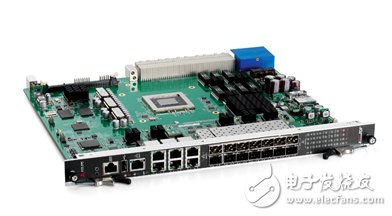ADLINK, the industry leader in embedded computer products and intelligent computer application platforms (ApplicaTIon Ready Intelligent Platforms), unveiled the new AdvancedTCA® (ATCA) processor aTCA-3710 with FreescaleQorIQ P204 quad-core processor and Broadcom ® BCM56846 switch chip enables 10/40GbE multi-layer data exchange, and BCM56334 Gigabit switch chip supports 24-port 1G and 2-port 10G HiGig network interfaces for high bandwidth transmission. The aTCA-3710 provides 14 10GbE SFP+ uplink interfaces and supports 640 Gb/s data transmission. It is designed for next-generation 4G/LTE telecom applications and is ideal for network monitoring, network security, and wireless network switches (Wireless AP Controller). ), video streaming, deep packet inspection (DPI) and other applications that require high data throughput.

aTCA-3710
With the popularity of mobile devices and the emergence of various high-bandwidth applications, telecom operators are actively upgrading their devices to provide 4G/LTE ultra-wideband telecom services in line with next-generation telecommunications. To meet this industry trend and demand, ADLINK has introduced a complete line of carrier-grade products with 40 GbE data transmission switching interfaces, including blade processors, blade switches, and chassis, enabling telecom equipment vendors to develop high-bandwidth applications. .
ADLINK's aTCA-3710 40G ATCA blade switch, compliant with PICMG® 3.0 R3.0 and PICMG® 3.1 R2.0 specifications, is a high-performance switching processor product. ADLINK's Intelligent Application Platform (ARIP) provides softness. The hardware integration application, taking the telecommunications network as an example, includes a CPU/NPU blade processor, a blade switch, and network software (ADLINK Software for Network). The aTCA-3710's rich I/O front panel and hot-swappable design ensure high system convenience, scalability, and ease of maintenance.
ADLINK Software for Networking (ADSN) is a complete and optimized middleware that facilitates system integrator (SI) system configuration, management, and switch status monitoring. ADLINK hardware products such as aTCA-3710 Collocation, become the 40G Intelligent Application Platform (ARIP), and through the full compatibility testing and verification of ADLINK, it helps telecom equipment vendors accelerate system deployment and reduce construction costs, which can enable them to achieve shorter time-to-market. Increase market competitiveness.
ADLINK has been implementing AdvancedTCA® technology for nearly a decade, and its products have been supplied to a global leader in telecom equipment manufacturers and are your best telecommunications solution partner.
The pigtail refers to an optical fiber or optical cable with an optical fiber connector installed at one end and an optical fiber or optical cable at the other end. Divide an optical jumper into two to become two optical pigtails. Optical pigtails are usually used for the end of the optical path (such as the actual test result box of the terminal point pair, the splice tray in the wiring equipment, etc.). Or the extraction of optical devices (such as optical splitters, lasers, detectors, etc.). The pigtail length is usually no more than 2 meters.
Same as the optical jumper, when the connecting wire is an optical cable (mostly indoor optical cable), it is called an optical fiber pigtail, and when the connecting wire is an optical fiber (usually a tight-buffered optical fiber), it is called an optical fiber pigtail. There is no special product standard for optical pigtails. Most buyers and sellers switch to "arbitrary type" in the form of optical patch cords when they deliver. The quality acceptance is the same as optical patch cords, which also apply optical fiber movable connector standards.
Pigtails are divided into multi-mode pigtails and single-mode pigtails. The multimode pigtail is orange, the wavelength is 850nm, the transmission distance is 5Km, and it is used for short-distance interconnection. The single-mode pigtail is yellow, with two wavelengths, 1310nm and 1550nm, and transmission distances of 10km and 40km, respectively.
Fiber is an important component of the optical communication system, which is mainly used to realize the two functions of the interconnection of the optical ports between the devices and the interconnection of the device and the fiber core of the optical cable. Different from conventional cables, the pigtail core wire has the characteristics of easy breakage and weak tensile performance, and there is no mature on-site processing plan for the interface components, and it is impossible to make a pigtail with a suitable length on site according to the actual distance. Therefore, in practical applications, the pigtails are usually factory-processed and manufactured according to a certain nominal length series. When installing and constructing on site, engineers can choose pigtails that are longer than the actual distance. Because pigtails have the characteristics of discretization and easy damage, pigtail reeling is the core link in the installation, return and storage of pigtails.
The inner core of the pigtail uses silica glass filaments to carry the optical path. The body is fragile and easy to break. The main line is usually a 48-core ADSS optical cable. These pigtails need to be sheathed in a corrugated tube and placed in the floor compartment or cable sandwich. There is no effective tool assistance in the traditional pigtail threading method, and the operation and maintenance personnel adopt the traditional brute force method to pass the pigtail through the corrugated tube, which causes more fiber jumper damage and high probability of service interruption.
Fiber Optic Pigtails,plc splitter,Sc Bunch Pigtail Cable,Pigtail
Shenzhen GL-COM Technology CO.,LTD. , https://www.szglcom.com